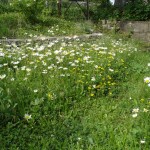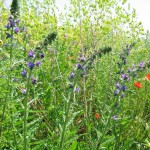Examples of use
In public green in settlements for
- roof greening
- gravel lawn
- colorful perennial herb borders
- traffic islands, traffic secondary areas
- park meadows
- more often mown herbal lawn
- stormwater overflow
- interim greening of short-term industrial wasteland
- art projects

roof greening

Roadside green

Public green

art project

gravel lawn

successful sowing
In privat gardens
- flower lawn
- lawn and meadows
- paved stone joints
- stonewalls

flower lawn

butterfly hem

sowing
In the open countryside
- renaturation after construction projects
- compensation areas
- eco-accounts
- flower strips in cropland located in impoverished agricultural landscapes
- nature conservation expertise of plant communities
- development of renaturation projects

blooming hem

renaturation area

Upgrading of plant communities
Native plants and seeds are used in almost all areas of the landscape, even in populated areas. The main area of use is in the open countryside for the greening of newly designed areas (for example roadsides, next to building land, heaps, recultivation surfaces).
Furthermore, the planting of species-rich perennials or grassland is carried out as compensatory or supplementary land for nature conservation. Particularly magnificient native species are popular in the garden area or in well-kept parks. As design elements, wild plants are increasingly used in representation or traffic-accompanying areas in inner-city areas.
Some projects also focuse on promoting the diversity of native animal species in cleared landscapes. Species-rich stocks increase the local recreational value. These species-rich stocks are, in comparison to pastures, richer in color and over the summer they are equipped with changing color aspects (e.g. bee hems, butterfly mixtures, wild field seeding, high perennials on water edges).